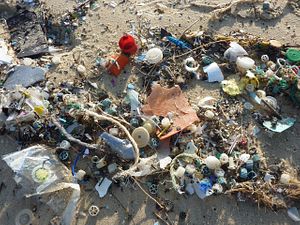The past year saw several upsetting events related to marine pollution in Southeast Asia’s waters. First, in June 2018, a pilot whale died in Thailand and some 80 pieces of plastic rubbish weighing 8 kilograms were found in its stomach. Then in November, a dead sperm whale found in the waters around Wakatobi, Indonesia was reported to have ingested almost 6 kg of plastic waste. Unfortunately, the sad trend did not stop there. This March, a dead whale was found in the Philippine waters with the same condition. Those are only some of the devastating examples of the effect of marine litter.
ASEAN has been under fire for marine pollution. Four of its member states are among the biggest polluters of the oceans: Indonesia, the Philippines, Vietnam, and Thailand. But ASEAN has been working to solve the issue. The recent 34th ASEAN Summit, held in Thailand in June, issued two important documents related to protection of the marine environment. The Bangkok Declaration on Combating Marine Debris in the ASEAN Region and the ASEAN Framework of Action on Marine Debris (Framework of Action) are two cornerstone documents in combating marine debris in Southeast Asia. Together, they are the answer to various criticisms of ASEAN’s effort to combat marine pollution. This is also an important moment for the region as a whole to contribute to combating marine pollution. Speaking about the new documents, Singapore’s Prime Minister Lee Hsien Loong pointed out that many current environmental challenges are transboundary in nature, which makes it impossible for any single country to solve the issue alone.
The Framework of Action in particular has several important features. The framework aims to strengthen collaborative action among the ASEAN member states and partners to prevent and significantly reduce marine debris, including debris produced from both sea-based and land-based activities. The inclusion of land-based activity is essential, since land-based sources such as industrial outflows and improper waste disposal are the biggest contributors to maritime pollution.
Further, ASEAN incorporated in the Framework of Action the possibility to establish an ASEAN Center on Combating Marine Debris. If realized, this can be an important institution in the region. The center can act as the source of information for ASEAN member states, a central organization that promotes cooperation and coordination and is responsible for various programs related to marine debris. In a related example, the ASEAN Center for Biodiversity already facilitates cooperation and coordination among ASEAN member states related to conservation of biodiversity in the region and serves as the secretariat for the ASEAN Heritage Parks program. The establishment of an ASEAN Center on Combating Marine Debris could similarly strengthen cooperation among ASEAN member states and also contribute significantly to solving global marine pollution.
The big question, however, is whether the Framework of Action can be put into action through a binding legal instrument or whether it will only end up as a “framework” without any binding power over the ASEAN member states.
Looking back, ASEAN is known for not being proactive in combating environmental issues. Part of the problem is the group’s lack of commitment to creating a binding legal instrument to protect the environment. One notable example is ASEAN’s approach to the transboundary air pollution in the region. During and before 1997 and 1998 there were various haze events in the region, serious enough to be considered an “environmental disaster.” The criticisms toward ASEAN’s inaction even came from ASEAN’s secretary general himself. At that time, Secretary General Rodolfo Severino said that ASEAN’s visible unwillingness or inability to take timely and concrete cooperative steps raised doubts about ASEAN’s methods, effectiveness, and relevance. Only after 1998, which marked the most severe period of haze in Southeast Asia, were ASEAN member states forced to agree to establish a legally binding mechanism to settle the haze issue. The Agreement on Transboundary Haze Pollution was signed as a binding agreement to solve transboundary haze in 2002. This was a positive development for ASEAN as a regional institution, and also helped counter the image that ASEAN was not taking proactive action on environmental issues.
The effectiveness and implementation of an international agreement are not necessarily dependent upon whether a legal instrument is binding or not. Nevertheless, it is still a factor and the most traditional way to ask for a clear commitment and to change state behavior toward an issue. In this case, if ASEAN member states are unwilling to further create a legally binding instrument, this might also influence the implementation of the Framework of Action in the future.
There must be a commitment from each of the member states to agree on the creation of such a binding instrument. ASEAN needs a proactive approach to solve the transboundary issue of marine debris. If this leads to a legally binding instrument, ASEAN must not fall victim to the same roadbloacks — ASEAN had to wait until 2014 for Indonesia to ratify the Agreement on Transboundary Haze Pollution even though the haze pollution was mainly coming from Indonesia’s territory. Due to that, robust cooperation and commitment between ASEAN member states remains an important factor for the implementation of the Framework of Action. A constant negotiation must be conducted with good faith to reach a common understanding among ASEAN member states.
It is obvious that we cannot expect much from a framework document. It is not a legally binding instrument and the document dwells more on the general rather than the specific. However, other countries outside ASEAN expect positive results from this framework document, considering that four countries in ASEAN are among the biggest ocean polluters. Hopefully, this latest accord will not only end up as a framework with no legally binding power. It will be unfortunate if there is no clarity on the implementation of the good initiatives written within the Framework of Action.
Fachry Hasani Habib is an LL.M Candidate at Utrecht University’s Public International Law program, specializing in the environment and the Law of the Sea.

































